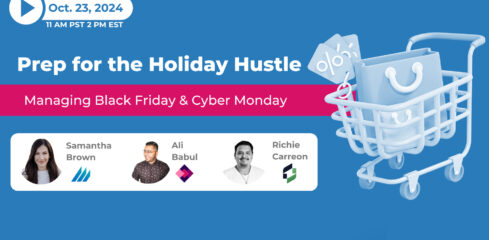
Quarter 4: a season synonymous with festivities, family reunions, and fervent shopping. For businesses, it means meticulous planning to get ahead of Q4 in order to navigate the whirlwind of sales, promotions, and elevated customer expectations. Let’s explore the intricacies of Q4 inventory demand planning, and we’ll talk over some action ideas for sellers to implement.
Q4 Demand Planning is Crucial
Inventory demand planning for Q4 isn’t a casual month-long affair. It requires an extended forward strategy to align with suppliers, comprehend inventory and warehouse costs, liaise with carriers, and frame a promotional game plan. The crux? Evading the two big no-nos of retail: overselling and overstocking.
A study from Adobe Analytics divulges an eye-opener: U.S. online shoppers splurged $211.7 billion during the 2022 holiday season, marking a 3.5% YoY growth. This trajectory only accentuates the significance of impeccable planning for this crucial period so that businesses can have a profitable Q4.
Striking the Right Balance
At the heart of Q4 planning is discerning how much to order. The equilibrium is delicate. Overordering leads to surplus stock and subsequent post-holiday discounted sales, seriously denting profits. Conversely, underordering culminates in overselling, damaging your customer relationships and your business’s reputation. Not surprisingly, sellers incur a staggering $1.77 trillion annual loss due to overselling. Hence, optimizing inventory levels—neither excessive to induce overstock nor scanty to provoke overselling—is imperative. To avoid these issues, you should look at data trends, internally and externally, within your specific industry and the ecommerce industry.
How Sellers Order on Plan
When looking at trends, following historical sales trends throughout the year is the best way to start. Those and other statistics can help you make informed decisions about stock levels, ensuring that you neither overstock nor understock. Thus, sellers can order strategically by meticulously analyzing past sales data while safeguarding their bottom line.
Historical Sales Data
Start with internal metrics. Investigate prior year sales patterns. These historical data points can guide you in anticipating customer demand and understanding which products are more resilient to price fluctuations. Pay special attention to understanding your bestsellers and their recent sales trends, keeping in mind that last year’s bestsellers may not be this year’s choice picks.
Current Market Forecasts
Exploring retail forecasts offers a snapshot into overall economic health and consumer confidence and offers a clue of how consumers will spend in Q4, as retail spending is closely linked to consumer sentiment and purchasing power. For instance, NRF’s forecast for a 4-6% growth in 2023 over the 7% annual growth in 2022. These numbers are about 3% higher than pre-pandemic rates, which saw about a 2-3% rise YoY. It suggests a degree of economic resilience and adaptability in the retail sector, even in the face of global challenges.
E-Commerce Giants as Benchmarks
Earnings reports from giants like Amazon are treasure troves. They don’t just state fiscal results but depict market tendencies and evolutions. For instance, according to Amazon’s Q3 quarter report, sales surged by 15% to $127.1 billion YoY from 2021 to 2022, furthering the impact of the marketplace giant. Sellers should see this shift and adjust their stock accordingly. How are businesses going to allocate stock differently between their marketplace and webstores? Sellers should understand what percent of orders comes from each sales channel: for some, Amazon may reign as the most lucrative sales channel; however, others may find that their webstore pulls in more orders than marketplaces. As a reminder, for those who do Amazon FBA, sellers should allocate a set hold of inventory or safety stock thresholds as backup plans to replenish as sales happen quickly.
The Macroeconomic Landscape
Ponder over macro factors—inflation, consumer sentiment, and global events. The U.S. inflation rate for 2023 lingered around 3.2%. Even slight inflation fluctuations can sway consumer purchasing dynamics, with this number still rising as 2023 wears on. Interestingly, despite grappling with inflation and the cost-of-living squeeze in 2022, U.S. online sales on Black Friday touched $9.1 billion, a 2.3% YoY rise, and in 2023, experts expect a 4.5% increase in holiday spending.
Crafting a Promotional Plan
Visibility is paramount amidst the Q4 hustle. Preparing for Black Friday or the Cyber 5? Have you locked up a spot for Amazon Lightning Deals? You need to ensure you have extra stock for the products you know will be in demand, especially if you planned promotions for specific items. If you oversell during your lightning deal spot, you could stand to lose hundreds of thousands of dollars and risk your chances of being awarded a lightning deal opportunity again in the future.
Furthermore, managing inventory across different sales channels – a physical location, ecommerce store, and marketplaces – demands a segmented approach to ensure efficient stock levels and optimized customer experience. For businesses with brick-and-mortar stores, be ready for foot traffic, especially on peak shopping days like Small Business Saturday, slated for November 25, 2023. Implement an integrated system that bridges your Amazon seller account with your in-store inventory. This facilitates the Buy Online, Pick Up In-Store (BOPIS) plan, enabling customers to purchase online and collect in-store.
Make sure to segment your inventory to allocate specific quantities for in-store purchases, online sales through your ecommerce platform, and sales through marketplaces like Amazon. By setting inventory thresholds for each channel, you can prevent overselling and overstocking and ensure that you always have products available for each type of customer.
Boosting Sales Through Product Plans
Besides wooing new customers, upping the ante with existing ones is equally potent. Kits and bundles have become a pivotal strategy for sellers, especially during the festive holiday season. To enhance existing customers’ loyalty and encourage repeat purchases, curated selections offer added value and a tailored shopping experience. Plus, they promote faster shipping times due to streamlined warehouse processes, further boosting customer satisfaction. Moreover, with bundles potentially amplifying revenues by 10-30%, as Shopify suggests, it’s a strategy worth investing in. By grouping together multiple products at a perceived discounted rate, customers often feel they’re obtaining greater value, which is especially appealing when searching for gifts. This bundled approach simplifies the gift-giving decision for many shoppers.
More significantly, bundles provide an avenue for upselling. Shoppers may come for a single item but leave with a bundle, increasing the Average Order Value (AOV). A higher AOV directly translates to heightened profitability for businesses. In essence, bundling during the holiday season can be a win-win, driving both seller success and customer satisfaction.
Mapping out the Timelines
While the official onset is Black Friday, the actual rush now starts as early as October’s end. With “Christmas Creep” setting in, a 2022 study indicates that nearly 60% of people begin their holiday shopping in early November or even before, underscoring the need to be inventory-ready much in advance. Let’s go over some action points to get sellers started.
Action Points:
- Understand supplier lead times and always have a cushion. While you would normally send out purchase orders (POs) 3.5 weeks in advance to needing items, err on the side of caution and submit POs 5 weeks prior for a fully stocked inventory by the end of October or the beginning of November. This means sellers need to send out POs, well, now at the start of September.
- Be sure to check the 2023 Q4 shipping deadlines for FedEx and UPS (to be updated) so you can post a banner on your website encouraging last-minute customers to order to get their packages on time.
- Have staff ready to take on extra shipments coming into the warehouse, and make sure that you have the shelf space for inflated product intaking.
- Ensure you’re focusing on the right channel strategies across your various sales platforms (i.e., Amazon, Etsy, Shopify, physical stores). Early Q4, you should emphasize your webstore because, based on the above shipping deadlines, customers will get their orders on time. But as we get closer to the bigger holidays, people start to buy things last minute, which is why Amazon’s two-day shipping might have you shift to your FBA strategy due to peak delivery timetables.
Mastering Demand Planning for Q4 Success
Orchestrating Q4 inventory demand planning is akin to executing a complex ballet. Precision, vision, and agility are indispensable. Every business has its unique rhythm, but a combination of adaptability and data-backed decisions ensures not just survival but true Q4 success. In today’s fluctuating marketplace, aligning strategies with pertinent stats and industry insights guarantees sellers can sail smoothly through Q4 while optimizing their revenue stream.
Finale Inventory offers a customizable solution for sellers aiming to excel in inventory management, including procurement and reordering for demand planning. Seamlessly integrated with multiple sales platforms, Finale aids in optimizing inventory levels, preventing overselling and overstocking, and facilitating workflows that streamline warehouse processes.
Navigate Q4 with confidence, and let Finale help you with your demand planning!





